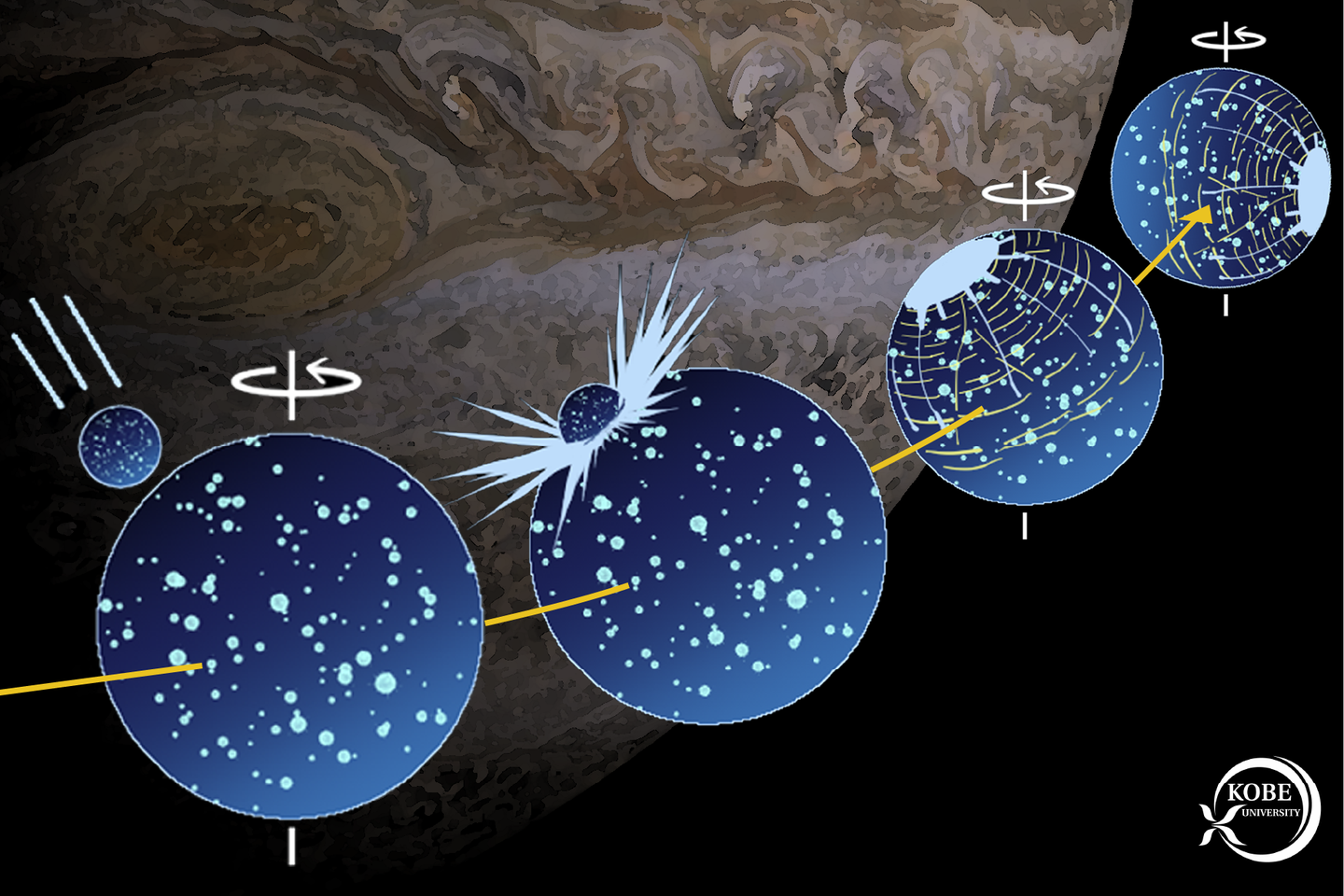Gigantic asteroid impact knocked the Solar System’s biggest moon off its axis
About 4 billion years ago, a massive asteroid struck Ganymede, the largest moon in the Solar System causing the moon’s axis to shift.

Kobe University HIRATA Naoyuki was the first to realize that the location of an asteroid impact on Jupiter’s moon Ganymede is almost precisely on the meridian farthest away from Jupiter. This implied that Ganymede had undergone a reorientation of its rotational axis and allowed Hirata to calculate what kind of impact could have caused this to happen. (CREDIT: HIRATA Naoyuki)
About 4 billion years ago, a massive asteroid struck Ganymede, the largest moon in the Solar System. This colossal impact left more than just a crater; it caused the moon’s axis to shift.
According to recent research by Dr. Hirata Naoyuki from Kobe University, the asteroid was roughly 20 times larger than the one that ended the dinosaurs on Earth. The impact ranks as one of the most significant in the Solar System, leaving clear evidence behind on Ganymede’s surface.
Ganymede, a moon of Jupiter, is even larger than the planet Mercury and has intrigued scientists for years due to its subsurface oceans beneath a thick icy shell. Like Earth’s moon, Ganymede is tidally locked, meaning it always shows the same face to Jupiter, while the far side remains hidden.
One unique feature of this moon is the extensive system of furrows on its surface, forming concentric rings around a specific point. In the 1980s, scientists theorized these furrows were the result of a major impact, though details about the event remained uncertain.
Dr. Hirata, a planetary scientist specializing in moon and asteroid impacts, became particularly interested in these furrows. "The Jupiter moons Io, Europa, Ganymede, and Callisto all have interesting individual characteristics, but the one that caught my attention was these furrows on Ganymede,” he explained.
Related Stories
The challenge, however, was understanding how large the impact was and what effects it had on Ganymede. Despite the moon’s proximity to Earth compared to other celestial bodies, data on Ganymede is limited, making research difficult.
By closely examining Ganymede’s surface and its relationship with Jupiter, Dr. Hirata made a significant discovery: the suspected impact site lies almost exactly on the point farthest from Jupiter. This observation led him to draw parallels with a similar event on Pluto, where an asteroid collision shifted the dwarf planet’s rotational axis.
In Pluto’s case, NASA’s New Horizons probe provided crucial information. Similarly, the idea of a shift in Ganymede’s axis gave Hirata the insight needed to calculate the size of the asteroid that struck the moon.
In his study, published in Scientific Reports, Hirata’s simulations revealed the asteroid that hit Ganymede likely had a diameter of around 300 kilometers—far larger than the asteroid that wiped out the dinosaurs 65 million years ago. This massive rock would have created a transient crater between 1,400 and 1,600 kilometers in diameter. A transient crater is the cavity formed right after an impact, before the material settles into a final shape.
According to Hirata’s findings, only an impact of this magnitude would have caused the significant shift in Ganymede’s axis. The change in the moon’s mass distribution due to the crater’s formation was enough to alter its orientation, regardless of where the asteroid struck.
This new understanding sheds light on Ganymede’s history and may help researchers better grasp how it and other moons of Jupiter evolved over billions of years. "I want to understand the origin and evolution of Ganymede and other Jupiter moons. The giant impact must have had a significant effect on the early evolution of Ganymede," Hirata stated.
While much of Ganymede’s surface features are linked to this event, the internal effects remain unexplored. He noted, "The thermal and structural effects of the impact on the interior of Ganymede have not yet been investigated at all." The next step in Hirata’s research may involve studying how such impacts affected the internal evolution of icy moons like Ganymede.
What makes Ganymede even more compelling is its subsurface ocean, which could potentially harbor life. The European Space Agency’s (ESA) JUICE (Jupiter Icy Moons Explorer) mission is set to provide valuable data on Ganymede.
Scheduled to reach the moon by 2034, JUICE will orbit Ganymede for six months, conducting detailed observations. The spacecraft’s findings could help answer lingering questions about the moon’s geology, its potential to support life, and the role that asteroid impacts have played in shaping its evolution.
Ganymede’s furrows, which first piqued scientists' curiosity in the 1980s, are now understood to be the result of a massive asteroid impact, one that shifted the moon’s axis and left a lasting mark on its surface. Dr. Hirata’s research brings us closer to understanding this event and its consequences for Ganymede’s development.
As more missions like JUICE explore our Solar System’s moons, there is hope that these discoveries will offer insight into the origins and evolution of not just Ganymede, but other celestial bodies as well. Through continued study, the mysteries of these icy worlds might soon unravel.
Note: Materials provided above by The Brighter Side of News. Content may be edited for style and length.
Like these kind of feel good stories? Get The Brighter Side of News' newsletter.



